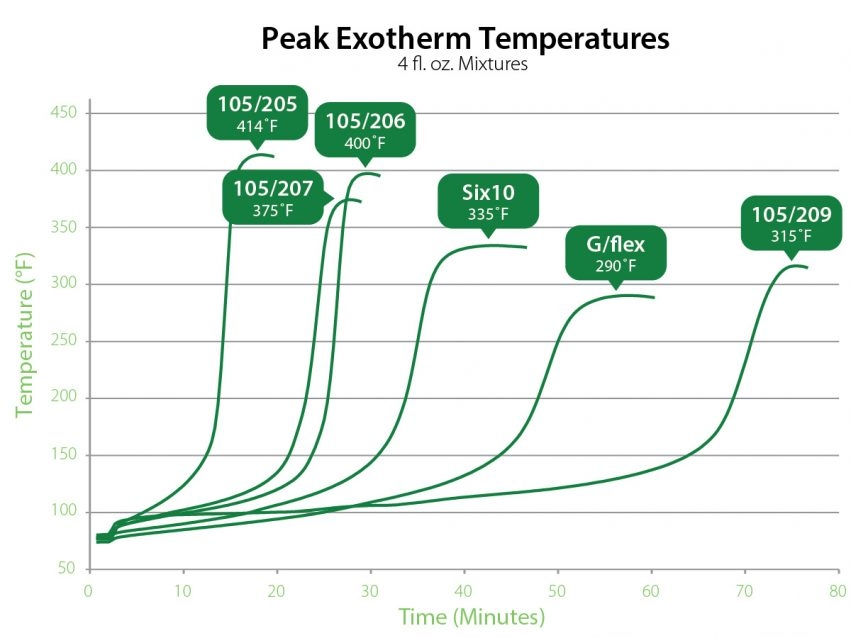THE BASICS of Uncontrolled Cure
The chemical reaction that cures mixed epoxy is exothermic, or heat-generating. If left to cure in a contained mass such as in a mixing pot it can generate enough heat to melt plastic, burn your skin, or ignite surrounding combustible materials. The larger or thicker the epoxy mass, the more heat generated and the more likely an uncontrolled cure will occur. A 100-gram mass of mixed epoxy can reach 400°F.
To prevent heat buildup and uncontrolled cure, transfer epoxy from the mixing pot to a roller pan or other wide, shallow container. Fill large cavities with epoxy in multiple layers rather than in a single, thick layer. Heat build-up and uncontrolled curing (exotherm) are unlikely in typical bonding and coating jobs because spreading the epoxy into thinner layers dissipates heat.
During uncontrolled cure, mixed resin and hardener become hot and frothy as they thermally decompose, generating toxic vapors. These include carbon monoxide, oxides of nitrogen, ammonia, and possibly some aldehydes. Cured epoxy can emit similar vapors if you heat it too much. This can happen when you use a flame to release epoxy-mounted hardware. To reduce this risk, use just enough heat to release the hardware. If you must do so, work in a well-ventilated area.
While leftover mixed epoxy cures, set the container aside where you can monitor it. Use a fan to disperse vapors and direct them away. Air-purifying respirators may not be effective against these vapors.
Spontaneous combustion is a danger when hardeners are mixed with sawdust, wood chips, or other cellulosic materials. When hardener is spilled onto or mixed with sawdust, the air and moisture react with the amine to generate heat. If the heat is not dissipated quickly enough, it can ignite the sawdust. Do not use sawdust or other cellulosic materials to absorb a hardener spill. Likewise, do not pour unused hardener into a trashcan with sawdust or other cellulosic materials.
WEST SYSTEM® Epoxy resin and hardeners are classified as non-flammable because their flash points are greater than 200°F and they evaporate slowly. Furnaces, wood stoves, and other heat sources do not pose a serious fire hazard in the presence of epoxy vapors.

Controlling Exotherm
Proven methods for controlling exotherm.
If you do want to pour or cast a large volume of epoxy, here are several proven methods for minimizing heat buildup which we’ve developed over the years.
Pour the epoxy in timed, multiple batches.
Timing is important when doing multiple pours. Ideally, you want to wait for mild exotherm to peak and begin falling before mixing a new batch and pouring. Waiting too long could cause an insufficient bond between the two pours. Not waiting long enough can cause too much heat to build and cracks to propagate.
Choose 209 Extra Slow Hardener or G/flex.
A slower cure allows a deeper pour before too much heat buildup occurs. For this reason, we recommend using our slowest systems when casting larger amounts of epoxy: 105 Epoxy Resin® with 209 Extra Slow Hardener®, or G/flex®.
Work at cooler temperatures.
Cooler shop temperatures and cooling the epoxy itself will both work to your advantage in slowing cure and controlling epoxy’s exothermic reaction. A deeper pour can be accomplished with less heat buildup by starting with cooled epoxy and a cool substrate until the epoxy initially cures to a soft solid. Then you could expose it to room temp or higher to complete the cure.
Use heat sinks.
A heat sink is an object that can absorb a lot of heat. If you are applying the epoxy into or over a heavy metal object, it will absorb much more heat than a lower-density object.
High-density fillers can also act as a heat sink, reducing exotherm by absorbing more heat than a low-density filler and taking up more volume. This leaves less room for mixed resin and hardener, reducing the resulting heat reaction.
If the wrong epoxy/filler combination is used for a certain cure temperature, the epoxy may generate enough heat to smolder and burn. Adding more low-density filler will certainly reduce the amount of epoxy in a given volume, but the filler will act as an insulator instead of a heat sink. —From Controlling Exotherm by Mike Barnard in Epoxyworks® 39.
